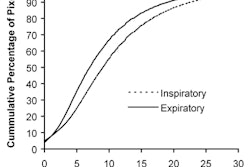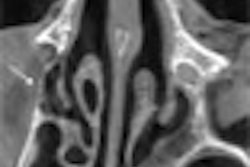Dr. David Lieberman, gastroenterologist and noted expert in colon cancer screening, thinks virtual colonoscopy has an important job to do. The former American Society for Gastrointestinal Endoscopy president believes that VC and its associated lesion surveillance offer an unprecedented opportunity to learn more about the natural history of colorectal polyps.
At the 2005 International Symposium on Virtual Colonoscopy in Boston, Lieberman suggested that VC could potentially become an integral component of colorectal cancer screening in the U.S., depending on factors yet to be determined, such as cost and which patients are ultimately referred for optical colonoscopy follow-up.
Currently, drawbacks to optical colonoscopy may be the single most important factor in VC's favor. "There are obstacles to doing screening colonoscopy," Lieberman said. "One, it's just not fun. Patients don't particularly want to have invasive procedures -- it's uncomfortable and it's not perfect.
The risks associated with screening optical colonoscopy have been highlighted by the radiology community, he said, which has also succeeded in demonstrating colonoscopy's sensitivity limitations by finding lesions that were missed on the conventional exam.
"Studies that used segmental unblinding unblinded the gastroenterologists in terms of what we were missing," Lieberman said. These studies included the well-known U.S. Department of Defense trial led by Dr. Perry Pickhardt et al (New England Journal of Medicine, December 2003, Vol. 349:23, pp. 2191-2200), which "showed VC's potential," Lieberman said. As for VC in general, "I have no doubt that the technology will continue to improve, and whatever techniques you all figure out will reach that threshold, and I expect that to happen in the near future," he said.
On the other hand, some important issues are still left to be resolved in VC, including wide variations in reported sensitivity in studies, and questions about cost-effectiveness, which hinge on the issue of referral, Lieberman said.
"The big question, I think, is which patients should be referred for colonoscopy after having CTC (CT colonography or virtual colonoscopy). And we know that CTC is sensitive enough to detect small lesions."
Not all VC-detected lesions should or will be referred for optical colonoscopy and polypectomy, but the cutoff size will have a huge impact on costs, Lieberman said.
"So what is a positive CT study?" he asked. "Should it be a lesion greater than 9 mm? We know that in a screening population that's going to be 5% to 10% of patients, and that's certainly a reasonable threshold. If the referral threshold were lesions less than or equal to 1 cm, VC would probably be cost-effective."
But if the colonoscopy referral threshold is stricter, say lesions 5 mm and larger, as many as 25% to 30% of patients will be referred, in which case colonoscopy almost certainly will not be cost-effective, he said.
In 2005, leading researchers comprising the Virtual Colonoscopy Working Group published a draft reference proposal regarding the disposition of colorectal lesions detected with VC (which has since been published as a consensus proposal in Radiology, July 2005, Vol. 236:1, pp. 3-9). It recommends surveillance of lesions 6-9 mm approximately every three years, or referral for polypectomy if three or more such lesions are found. Patients with no VC-detected lesions 5 mm or larger are advised to return for repeat VC in five to 10 years.
Lieberman wondered if patients with smaller lesions would be comfortable waiting out the next surveillance exam. It raises an interesting dilemma for physicians who have to sit down with patients to discuss their VC results, he said -- "telling them 'well, the good news is that you only have a small polyp and what should we do with it?'"
There are options for dealing with all of these situations, but many patients and physicians "will be uncomfortable with the discussion," Lieberman said. "I think that most clinicians and patients are going to want colonoscopy if they have a lesion greater than 5 mm. We're going to have to do a re-education process with patients if we decide this should not be the threshold."
Lieberman makes a valid point, commented Pickhardt in an e-mail to AuntMinnie.com. In a high-volume VC practice at the University of Wisconsin, the group offers the option of same-day conventional colonoscopy for any VC-detected lesions 6 mm or larger.
"When we first started our VC screening program, we really had no idea what percentage of patients with 6-9 mm polyps would opt for VC follow-up versus same-day polyp removal at OC (optical colonoscopy)," he wrote. "From the initial 1,000+ patients, 65% of patients with a 6-9 mm VC-detected polyp opted for noninvasive surveillance and 35% went on to OC."
Since then the referral percentage has remained constant through nearly 2,500 patients, Pickhardt stated. In discussions with them it can be determined fairly quickly which ones would prefer noninvasive surveillance over immediate polypectomy.
"This is important, because we definitely don't want to pressure anyone into a decision one way or another," Pickhardt wrote. "The fact that the majority of patients with a VC-detected 6-9 mm polyp prefer VC follow-up may in part reflect a self-selected group of people seeking an alternative to OC in the first place. Our patient population is also fairly well-educated and capable of grasping the relative risks involved in this decision."
Fuzzy history
More research is needed on the natural history of colorectal polyps, Lieberman said, but studies going back to the 1970s offer important clues. For example, the detection of frank cancers in subcentimeter lesions have been "extremely rare," he said, but "there will be a few patients with villous histology and high-grade dysplasia."
Two studies he cited as examples included a paper by Sciallero et al that examined 3,052 subjects with colonoscopy. Among (n = 214) lesions smaller than 5 mm in diameter, the group found villous histology was seen in 14 (6.5%) and high-grade dysplasia in five (2.3%). Among lesions 6-10 mm (n = 174), villous histology was seen in 26 (15%) and high-grade dysplasia in eight (4.6%) (Gastrointestinal Endoscopy, September 1999, Vol. 50:3, pp. 314-321).
Another trial known as VA cooperative study #380, examined 3,121 patients (mean age 62.9 years, 96.8% male) with colonoscopy. The researchers found 877 adenomas smaller than 10 mm. Of these, 24 (2.7%) had villous histology, and 11 (1.3%) had high-grade dysplasia (NEJM, July 20, 2000, Vol. 343:2, pp. 162-168).
There is some evidence that some polyps regress, and it's clear that many adenomas will not progress at all, Lieberman said. About 70% of adenomas found in screening are tubular adenomas less than 1 cm.
"It appears that these patients with small lesions are probably at pretty low risk," he said. "And in fact a couple of studies have suggested that the colorectal cancer risk is similar to that of general population."
Epidemiologic studies, as well as surveillance studies that have followed patients for three to five years after removal of one or two small adenomas, suggest that patients who have one or two subcentimeter tubular adenomas removed are at lower risk than those with three or more such lesions, Lieberman said.
But whatever polyp reporting and colonoscopy referral thresholds radiologists settle on will have medicolegal implications. VC and colonoscopy are complementary technologies, and efficient referral of VC patients to colonoscopy will require the development of multispecialty centers so that patients can avoid the second bowel prep, he said.
"I think (VC) offers us an exciting research opportunity," Lieberman said. "We know very little about the natural history of small polyps. And I think based on current information, it would be very ethical and very reasonable to do a study using serial (VC) to follow the natural history. Screening can prevent colon cancer."
By Eric Barnes
AuntMinnie.com staff writer
March 20, 2006
Related Reading
MHC 1 levels tied to colorectal cancer prognosis, January 23, 2006
Novel feces analysis may help detect colorectal cancer, January 20, 2006
VC would raise screening costs, study concludes, October 31, 2005
What virtual colonoscopy misses might not matter, August 18, 2004
Group credits 3-D reading for best-ever VC results, October 15, 2003
Copyright © 2006 AuntMinnie.com



















